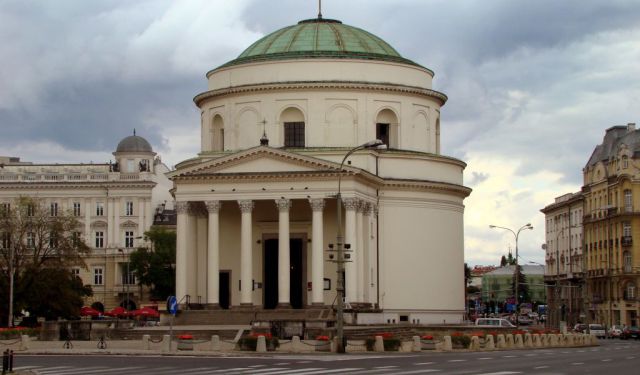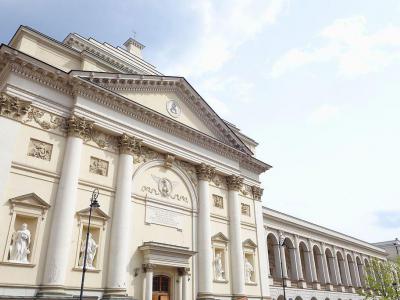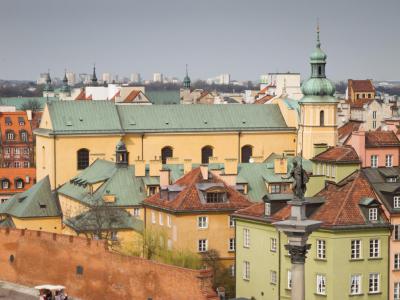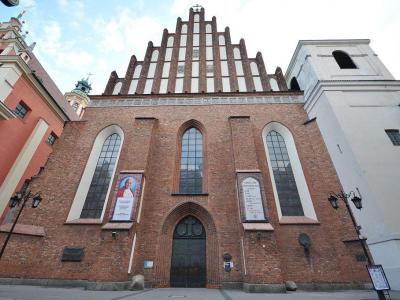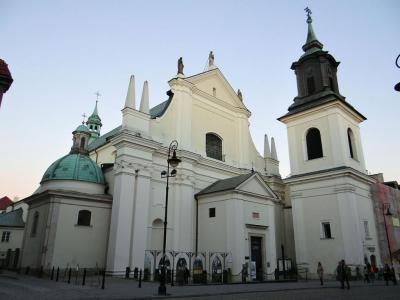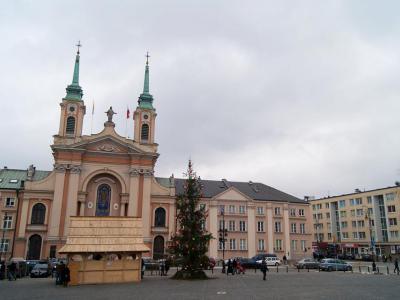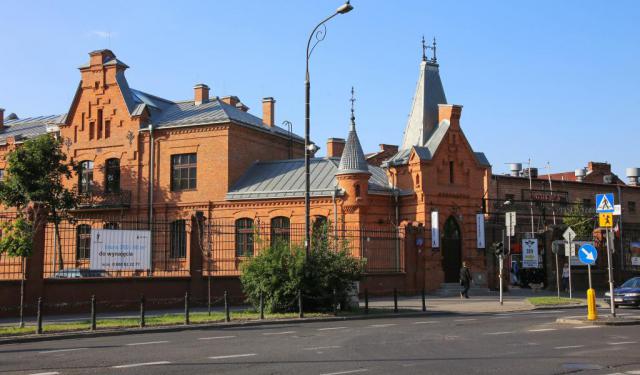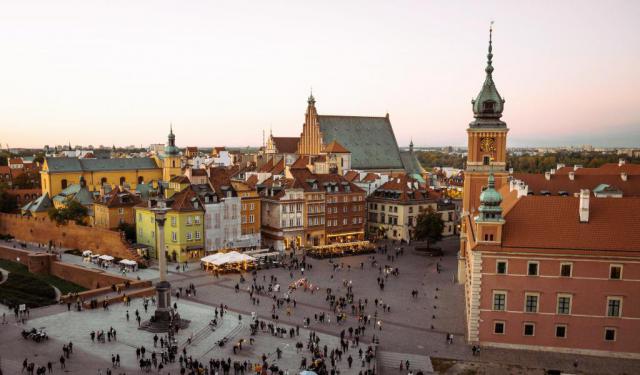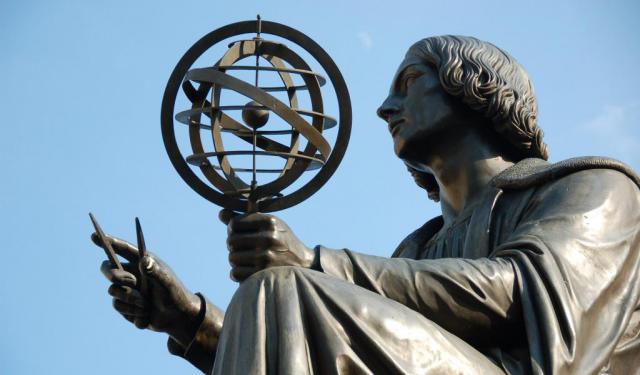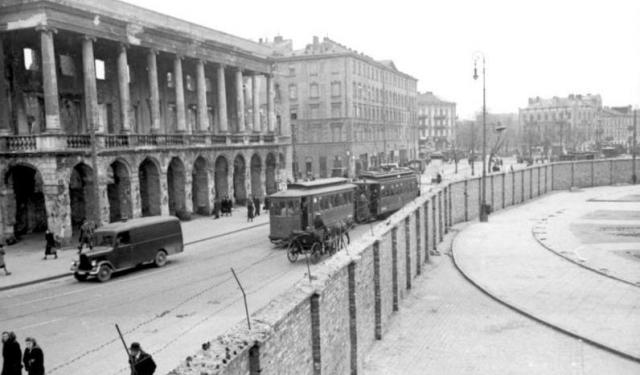Warsaw's Historical Churches (Self Guided), Warsaw
Given that Poland is one of the most religious countries in Europe – with Roman Catholicism being the dominant faith here since the Baptism of Poland in 966, – it is not at all surprising that Warsaw is home to many centuries-old churches and cathedrals. While reflecting the city's deep-rooted religious and cultural heritage, some of these historical temples are also magnificent architectural marvels fit to captivate the eyes of the beholder.
One such jewel is Saint Anne's Church, a splendid example of Baroque architecture with an ornate facade and elegant interior. The church's history dates back to the late 15th century, making it a true relic of the past.
Saint Martin's Church, situated in the Old Town, is another remarkable site. Its Rococo design, with intricate stained glass windows and stunning vaulted ceilings, transports visitors to a different era. Established in 1353, this sacred place has witnessed countless prayers and ceremonies throughout its long history.
Saint John's Archcathedral, a Gothic masterpiece, stands out among the rest with its distinctive red-brick pointed facade. Visitors to the cathedral can explore the crypt, housing the tombs of notable figures from Polish history.
The elegantly white silhouette of Saint Hyacinth's Church is a symbol of faith and resilience. Despite suffering damage during World War II, it has been lovingly restored and remains an important spiritual center.
The Field Cathedral of the Polish Army is a unique religious site with a military connection. It pays tribute to the country's armed forces and their sacrifices which, in a way, sets it apart from the city's other churches.
To fully appreciate Warsaw's historical places of worship, embark on this self-guided journey. Explore their architectural marvels, learn about their stories, and embrace the rich cultural heritage they represent.
One such jewel is Saint Anne's Church, a splendid example of Baroque architecture with an ornate facade and elegant interior. The church's history dates back to the late 15th century, making it a true relic of the past.
Saint Martin's Church, situated in the Old Town, is another remarkable site. Its Rococo design, with intricate stained glass windows and stunning vaulted ceilings, transports visitors to a different era. Established in 1353, this sacred place has witnessed countless prayers and ceremonies throughout its long history.
Saint John's Archcathedral, a Gothic masterpiece, stands out among the rest with its distinctive red-brick pointed facade. Visitors to the cathedral can explore the crypt, housing the tombs of notable figures from Polish history.
The elegantly white silhouette of Saint Hyacinth's Church is a symbol of faith and resilience. Despite suffering damage during World War II, it has been lovingly restored and remains an important spiritual center.
The Field Cathedral of the Polish Army is a unique religious site with a military connection. It pays tribute to the country's armed forces and their sacrifices which, in a way, sets it apart from the city's other churches.
To fully appreciate Warsaw's historical places of worship, embark on this self-guided journey. Explore their architectural marvels, learn about their stories, and embrace the rich cultural heritage they represent.
How it works: Download the app "GPSmyCity: Walks in 1K+ Cities" from Apple App Store or Google Play Store to your mobile phone or tablet. The app turns your mobile device into a personal tour guide and its built-in GPS navigation functions guide you from one tour stop to next. The app works offline, so no data plan is needed when traveling abroad.
Warsaw's Historical Churches Map
Guide Name: Warsaw's Historical Churches
Guide Location: Poland » Warsaw (See other walking tours in Warsaw)
Guide Type: Self-guided Walking Tour (Sightseeing)
# of Attractions: 5
Tour Duration: 1 Hour(s)
Travel Distance: 1.4 Km or 0.9 Miles
Author: leticia
Sight(s) Featured in This Guide:
Guide Location: Poland » Warsaw (See other walking tours in Warsaw)
Guide Type: Self-guided Walking Tour (Sightseeing)
# of Attractions: 5
Tour Duration: 1 Hour(s)
Travel Distance: 1.4 Km or 0.9 Miles
Author: leticia
Sight(s) Featured in This Guide:
- St. Anne's Church
- St. Martin's Church
- St. John's Archcathedral
- St. Hyacinth's Church
- Field Cathedral of the Polish Army
1) St. Anne's Church
The Neoclassical Saint Anne's Church is one of Warsaw's oldest buildings and most notable churches. Even though it has been rebuilt and reconstructed several times, its appearance has remained mostly unchanged since 1788.
The foundations were laid for the church back in 1454 when the Duchess of Masovia Anna Fiodorowna set it up for the Franciscan friars. In the 1700s, the facade was done in a Late-Baroque style. After suffering heavy damage in World War II, the church was restored between the late 1940s and 1970s.
The church impresses with its baroque style. It has a richly decorated interior that is full of beautiful frescoes. The only diamond vaulted ceiling is found here, in the cloister leading to the vestry. During the summer at noon, a 30 minutes organ concert is played every day except Sundays and holidays.
Inside the church, you will also find a simple wooden cross with an interesting history. The cross was built to commemorate the tragic loss of 96 lives in a 2010 Polish Air Force crash. The fatalities included the President of Poland, Lech Kaczyński, and his wife, Maria. The cross was displayed for a time at the Presidential Palace. However, the cross became a flashpoint in local politics, as it raised questions of the separation of church and state, religion, and Polish patriotism.
Why You Should Visit:
This church is completely painted from floor to ceiling with magnificent frescos. The illusions painted on the columns and walls are very beautiful.
Tip:
Try to schedule your visit around noon or 2pm to catch the daily organ concert (lasting 30 mins). It's also possible to climb to the top of the tower, which will earn you some impressive views over the city in a clear day.
The foundations were laid for the church back in 1454 when the Duchess of Masovia Anna Fiodorowna set it up for the Franciscan friars. In the 1700s, the facade was done in a Late-Baroque style. After suffering heavy damage in World War II, the church was restored between the late 1940s and 1970s.
The church impresses with its baroque style. It has a richly decorated interior that is full of beautiful frescoes. The only diamond vaulted ceiling is found here, in the cloister leading to the vestry. During the summer at noon, a 30 minutes organ concert is played every day except Sundays and holidays.
Inside the church, you will also find a simple wooden cross with an interesting history. The cross was built to commemorate the tragic loss of 96 lives in a 2010 Polish Air Force crash. The fatalities included the President of Poland, Lech Kaczyński, and his wife, Maria. The cross was displayed for a time at the Presidential Palace. However, the cross became a flashpoint in local politics, as it raised questions of the separation of church and state, religion, and Polish patriotism.
Why You Should Visit:
This church is completely painted from floor to ceiling with magnificent frescos. The illusions painted on the columns and walls are very beautiful.
Tip:
Try to schedule your visit around noon or 2pm to catch the daily organ concert (lasting 30 mins). It's also possible to climb to the top of the tower, which will earn you some impressive views over the city in a clear day.
2) St. Martin's Church
Saint Martin's Church, situated on Beer Street (ulica Piwna) in the Old Town of Warsaw, is a historic site with a rich history dating back to 1353. Established by Duke Siemowit III of Masovia and his wife Eufemia, the church was part of a larger complex that included the adjacent Augustinians cloister and the Hospital of the Holy Spirit intra muros.
The original church, a stone Gothic structure, was erected around the turn of the 14th and 15th centuries. Interestingly, its initial entrance faced the town walls, not Piwna Street as it does today. The church housed three altars: the main Saint Martin altar and two side altars dedicated to the Holy Ghost and Saint Dorothy.
The church underwent several transformations due to fires in the 15th and 17th centuries. Italian architect Giovanni Spinola was instrumental in its Baroque conversion. This included reorienting the church, moving the main entrance to Piwna Street, and relocating the altar to the southwestern side.
A significant reconstruction occurred around 1744, based on the design of Karol Bay. The main façade, featuring waved lines, is a prime example of the 'Melted Sugar' style in Rococo architecture. The central altar was revamped in 1751, featuring sculptures by Jan Jerzy Plersch, as per Bay's design.
While the exterior is Baroque, the interior underwent modernization. The original early Baroque furnishings by Jan Henel from the 1630s and the Rococo decorations of the 1750s were destroyed during the Warsaw Uprising by German bombing. Post World War II, the church was reconstructed.
Inside, the church features several chapels: the Chapel of Our Lady of Consolation with a 15th-century painting replica, the Chapel of Jesus Christ, and the Chapel of Saint Francis, which houses the church's most valuable item - a polychromed figure of the Virgin Mary with Child.
The original church, a stone Gothic structure, was erected around the turn of the 14th and 15th centuries. Interestingly, its initial entrance faced the town walls, not Piwna Street as it does today. The church housed three altars: the main Saint Martin altar and two side altars dedicated to the Holy Ghost and Saint Dorothy.
The church underwent several transformations due to fires in the 15th and 17th centuries. Italian architect Giovanni Spinola was instrumental in its Baroque conversion. This included reorienting the church, moving the main entrance to Piwna Street, and relocating the altar to the southwestern side.
A significant reconstruction occurred around 1744, based on the design of Karol Bay. The main façade, featuring waved lines, is a prime example of the 'Melted Sugar' style in Rococo architecture. The central altar was revamped in 1751, featuring sculptures by Jan Jerzy Plersch, as per Bay's design.
While the exterior is Baroque, the interior underwent modernization. The original early Baroque furnishings by Jan Henel from the 1630s and the Rococo decorations of the 1750s were destroyed during the Warsaw Uprising by German bombing. Post World War II, the church was reconstructed.
Inside, the church features several chapels: the Chapel of Our Lady of Consolation with a 15th-century painting replica, the Chapel of Jesus Christ, and the Chapel of Saint Francis, which houses the church's most valuable item - a polychromed figure of the Virgin Mary with Child.
3) St. John's Archcathedral
Saint John's Archcathedral, located in Warsaw, is a historically and architecturally significant landmark. Found in the Old Town area, this Catholic church sits on Świętojańska Street, near the Jesuit Church. It distinguishes itself as one of the three major cathedrals in Warsaw and holds the unique title of an archcathedral. As the primary church of the Archdiocese of Warsaw, it is also considered one of Poland's national pantheons. This cathedral, along with Warsaw's Old City, is designated as a UNESCO World Heritage Site.
The cathedral's origins date back to the 14th century when it was constructed in the Masovian Gothic style. Historically, it served as a site for the coronation and burial of many Dukes of Masovia. An interesting feature is the elevated 80-meter-long corridor connecting it to the Royal Castle, built in the late 16th century by Queen Anna Jagiellonka and extended in the 1620s.
Over the course of its history, Saint John's Archcathedral underwent several renovations. The most notable of these took place in the 19th century, preserving its English Gothic Revival architectural style until World War II. In 1944, during the Warsaw Uprising, the cathedral became a battleground between insurgents and the German army.
After World War II, the cathedral underwent significant reconstruction. The exterior was restored to its presumed 14th-century appearance based on 17th-century illustrations. The interior was redesigned to reflect a more authentic Gothic style, featuring a three-nave structure and various notable elements, including a 1959 pulpit, replica baroque stalls, chapels, gravestones, and epitaphs.
Why You Should Visit:
Not only is this, by itself, a beautiful building worth seeing, but it is also an important international centre to promote sacred music and its value certainly increases when you attend an organ concert (schedules can be found online).
Tip:
If you visit, make sure that your pictures are taken from the bottom up!
The small crypt can be viewed for a small fee, whereas the rest of the church is free.
Do wander through the tiny streets around the cathedral as they are atmospheric as well.
The cathedral's origins date back to the 14th century when it was constructed in the Masovian Gothic style. Historically, it served as a site for the coronation and burial of many Dukes of Masovia. An interesting feature is the elevated 80-meter-long corridor connecting it to the Royal Castle, built in the late 16th century by Queen Anna Jagiellonka and extended in the 1620s.
Over the course of its history, Saint John's Archcathedral underwent several renovations. The most notable of these took place in the 19th century, preserving its English Gothic Revival architectural style until World War II. In 1944, during the Warsaw Uprising, the cathedral became a battleground between insurgents and the German army.
After World War II, the cathedral underwent significant reconstruction. The exterior was restored to its presumed 14th-century appearance based on 17th-century illustrations. The interior was redesigned to reflect a more authentic Gothic style, featuring a three-nave structure and various notable elements, including a 1959 pulpit, replica baroque stalls, chapels, gravestones, and epitaphs.
Why You Should Visit:
Not only is this, by itself, a beautiful building worth seeing, but it is also an important international centre to promote sacred music and its value certainly increases when you attend an organ concert (schedules can be found online).
Tip:
If you visit, make sure that your pictures are taken from the bottom up!
The small crypt can be viewed for a small fee, whereas the rest of the church is free.
Do wander through the tiny streets around the cathedral as they are atmospheric as well.
4) St. Hyacinth's Church
Saint Hyacinth’s Church stands as a prominent tourist destination in Warsaw, showcasing splendid Baroque architecture that came into being during the years 1603 to 1639, courtesy of the Dominican order. This architectural masterpiece boasts an immaculate white interior, designed by none other than the renowned architect Joannes Italus.
The Chapel of Saint Dominic, an integral part of this church, was skillfully crafted by Tylman Van Gameren, a prominent architect of the seventeenth century in Poland. This chapel is intricately connected to Warsaw's largest monastery and remarkably stands as one of the few sections of the church that managed to survive the ravages of war.
In the eighteenth century, Saint Hyacinth’s Church experienced a period of great prosperity. During this time, it housed Poland's most opulent collection of volumines within the monastery's library. Unfortunately, this precious collection met its demise in later years, leaving behind only memories of its grandeur.
While the interior of the church has undergone modernization, with none of its original furnishings retained, its exterior façade remains a splendid example of Baroque architecture. Noteworthy within its hallowed walls are several prominent tomb monuments, including the striking tomb of Anna Tarnowska, carved in 1616 from brown marble, portraying the founder in a peaceful slumber. The Kararzyna Ossoliska monument, dating back to 1607, and the black marble epitaph commemorating a prosperous Polish merchant from Krakow, Regina Sroczyska, are among other notable features.
Within the confines of the Chapel of Saint Dominic, visitors can lay their eyes upon a precious 18th-century wooden statue of Ecce Homo, a masterpiece painstakingly crafted by Antoni Asiski. The chapel further boasts a grand altar crafted from black marble, a porta, and exquisite stucco decorations that add to the church's overall splendor.
The Chapel of Saint Dominic, an integral part of this church, was skillfully crafted by Tylman Van Gameren, a prominent architect of the seventeenth century in Poland. This chapel is intricately connected to Warsaw's largest monastery and remarkably stands as one of the few sections of the church that managed to survive the ravages of war.
In the eighteenth century, Saint Hyacinth’s Church experienced a period of great prosperity. During this time, it housed Poland's most opulent collection of volumines within the monastery's library. Unfortunately, this precious collection met its demise in later years, leaving behind only memories of its grandeur.
While the interior of the church has undergone modernization, with none of its original furnishings retained, its exterior façade remains a splendid example of Baroque architecture. Noteworthy within its hallowed walls are several prominent tomb monuments, including the striking tomb of Anna Tarnowska, carved in 1616 from brown marble, portraying the founder in a peaceful slumber. The Kararzyna Ossoliska monument, dating back to 1607, and the black marble epitaph commemorating a prosperous Polish merchant from Krakow, Regina Sroczyska, are among other notable features.
Within the confines of the Chapel of Saint Dominic, visitors can lay their eyes upon a precious 18th-century wooden statue of Ecce Homo, a masterpiece painstakingly crafted by Antoni Asiski. The chapel further boasts a grand altar crafted from black marble, a porta, and exquisite stucco decorations that add to the church's overall splendor.
5) Field Cathedral of the Polish Army
The Field Cathedral of the Polish Army stands as one of Poland's most renowned cathedrals, drawing visitors from both local communities and around the world. Situated across from Krasinski Square near the old town, this garrison church serves as a focal point for various military religious ceremonies.
The front of the church features a large tympanum with a sculpture of the Holy Mary, flanked by two low towers. Stone tablets beside the entrance honor historic Polish military units, and symbols of the armed forces (an anchor and propeller) are present. Inside, symbolic paintings depict famous Polish battles and uprisings, while a bronze gate showcases additional battles.
Originally constructed in the 17th to 18th centuries for the Piarist friars, the cathedral took on a different role during the tumultuous years of World War I. Following the Russian departure from Warsaw in 1915, the church transformed into a German army depot, remaining under their control for a number of years.
It wasn't until 1918, when Poland regained its independence, that efforts began to restore the cathedral to its former grandeur, a process that continued from 1923 to 1927. Oskar Sosnowski played a pivotal role in this restoration, drawing inspiration from 17th-century architectural designs.
Tragically, during the Warsaw Uprising of 1944, the cathedral suffered extensive damage at the hands of the Luftwaffe. However, between 1946 and 1960, a dedicated team of architects led by Leon Marek Suzin meticulously reconstructed and restored the cathedral to its present state.
Today, the Field Cathedral of the Polish Army stands as a significant historical and religious site in Warsaw, making it a must-visit destination for travelers exploring the city.
The front of the church features a large tympanum with a sculpture of the Holy Mary, flanked by two low towers. Stone tablets beside the entrance honor historic Polish military units, and symbols of the armed forces (an anchor and propeller) are present. Inside, symbolic paintings depict famous Polish battles and uprisings, while a bronze gate showcases additional battles.
Originally constructed in the 17th to 18th centuries for the Piarist friars, the cathedral took on a different role during the tumultuous years of World War I. Following the Russian departure from Warsaw in 1915, the church transformed into a German army depot, remaining under their control for a number of years.
It wasn't until 1918, when Poland regained its independence, that efforts began to restore the cathedral to its former grandeur, a process that continued from 1923 to 1927. Oskar Sosnowski played a pivotal role in this restoration, drawing inspiration from 17th-century architectural designs.
Tragically, during the Warsaw Uprising of 1944, the cathedral suffered extensive damage at the hands of the Luftwaffe. However, between 1946 and 1960, a dedicated team of architects led by Leon Marek Suzin meticulously reconstructed and restored the cathedral to its present state.
Today, the Field Cathedral of the Polish Army stands as a significant historical and religious site in Warsaw, making it a must-visit destination for travelers exploring the city.
Walking Tours in Warsaw, Poland
Create Your Own Walk in Warsaw
Creating your own self-guided walk in Warsaw is easy and fun. Choose the city attractions that you want to see and a walk route map will be created just for you. You can even set your hotel as the start point of the walk.
Praga District Walking Tour
Praga – not to be confused with the neighboring Czech Republic's capital city – is an old, yet vibrant district on the eastern bank of the Vistula River in Warsaw. For many years overshadowed by its more famous counterpart, Warsaw's Old Town, the area used to be off-limits for Western travelers due to its high crime rate. Recently, however, thanks to the lavish influx of investment,... view more
Tour Duration: 1 Hour(s)
Travel Distance: 2.1 Km or 1.3 Miles
Tour Duration: 1 Hour(s)
Travel Distance: 2.1 Km or 1.3 Miles
Warsaw Introduction Walking Tour
Warsaw rose to prominence when King Sigismund III moved the nation’s capital from Krakow in the 16th century. The city was widely known as the “Paris of the North” thanks to the beautiful boulevards lined with grand architecture. The center of the city is called Old Town, and it has many historic buildings like the Royal Castle on Castle Square and the Presidential Palace. Old Town is a... view more
Tour Duration: 2 Hour(s)
Travel Distance: 2.5 Km or 1.6 Miles
Tour Duration: 2 Hour(s)
Travel Distance: 2.5 Km or 1.6 Miles
Monuments and Statues
The capital city of a proud nation such as Poland, Warsaw is abundant with monuments of various sorts, dedicated to celebrated personalities and those who made a mark in the history of the country.
Some of these landmarks serve as reminders of the city's resilience and the enduring spirit of its people. Among them are the Jan Kiliński Monument commemorating a hero of the 1794 Kosciuszko... view more
Tour Duration: 2 Hour(s)
Travel Distance: 2.9 Km or 1.8 Miles
Some of these landmarks serve as reminders of the city's resilience and the enduring spirit of its people. Among them are the Jan Kiliński Monument commemorating a hero of the 1794 Kosciuszko... view more
Tour Duration: 2 Hour(s)
Travel Distance: 2.9 Km or 1.8 Miles
Jewish Warsaw Walking Tour
Once abundant, the Jewish population of Warsaw has left a profound mark on the city. Nowadays, walking along the peaceful streets of Poland's capital it is hard to imagine that thousands of Jews were once herded here and forced into cattle cars to meet their end in the Nazi concentration camps during World War II.
At the heart of this tragic chapter in Warsaw's Jewish history lies the... view more
Tour Duration: 2 Hour(s)
Travel Distance: 4.7 Km or 2.9 Miles
At the heart of this tragic chapter in Warsaw's Jewish history lies the... view more
Tour Duration: 2 Hour(s)
Travel Distance: 4.7 Km or 2.9 Miles
Useful Travel Guides for Planning Your Trip
15 Distinctively Polish Things to Buy in Warsaw
A country with a great deal of taste and turbulent history, Poland has a lot to offer those with the eyes to see and mouth to savor. And Warsaw is, perhaps, the best place to find all things Polish brought together. Here's the list of the most distinctive Polish goods, caringly drawn by a...
The Most Popular Cities
/ view all
